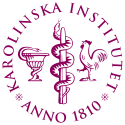Karolinska Institute
| Karolinska Institute | |
|---|---|

|
|
| motto |
Att förbättra Mänsklig hälsa - Improve human health |
| founding | 1810 |
| Sponsorship | state |
| place | Solna |
| country |
|
| president | Ole Petter Ottersen |
| Students | 5,962 FTE (2018) |
| Employee | 5,221 (2018) |
| including professors | 342 FTE (2018) |
| Annual budget | 7.131 billion SEK (2018) ≈665 million euros |
| Networks | IAU , LERU |
| Website | www.ki.se |
The Karolinska Institute (or Karolinska Institute, in older texts called the Royal Medical University; Swedish Karolinska Institutet, KI for short ) is one of Europe's largest and most prestigious medical universities, located in Solna and Huddinge near Stockholm . The Karolinska Institute brings together 40 percent of Swedish medical research at colleges and universities and is considered one of the best medical research institutions in the world. The Karolinska University Hospital (consisting of two large hospitals in Solna and Huddinge) is also affiliated with the KI .
The Nobel Assembly at the Karolinska Institute consists of 50 professors and annually determines the winner (s) of the Nobel Prize in Physiology or Medicine .
history
The institute was founded in 1810 by the Swedish King Charles XIII. founded to improve the training of the military paramedics, since a third of the wounded soldiers died in the field hospitals in the war against Russia from 1808-1809 . At first it was named Kongl. Carolinska medico-chirurgiska institutet . One of the founders was the chemist Jöns Jacob Berzelius . In 1861 the institute was raised to the rank of university. Alfred Nobel determined in his will that the Karolinska Institute should appoint the winners of the Nobel Prize named after him in medicine or physiology . A total of five researchers from the Karolinska Institute have received the Nobel Prize since then. In the 20th century, several institutions and universities were attached to the Karolinska Institute, so that it currently has around 3,000 students. In addition to the emphasis on research at the highest level, the institute has always dedicated itself to practical application, so from the outset it cooperated with the Gymnastik- och idrottshögskolan and integrated the Stockholm Institute of Physiotherapy in 1959 and the Stockholm University of Health Sciences into the KI in 1998 . In addition, the KI publishes a number of leading international specialist journals such as Acta Paediatrica .
Famous people working at the Karolinska Institute
List sorted chronologically by year of birth.
- Jöns Jakob Berzelius (1779–1848; Professor at the Karolinska Institute), invented the chemical notation used today and is considered one of the fathers of modern chemistry. He discovered the chemical elements silicon , selenium , thorium and cerium .
- Carl Gustav Mosander (1797–1858; student of Berzelius and his successor in 1836), discovered the elements lanthanum , erbium and terbium .
- Karl Oskar Medin (1847-1927), pediatrician, known as a polio researcher (professor 1883-1914)
- Patrik Haglund (1870–1937), orthopedist
- Ivar Wickman (1872–1914), pediatrician, lecturer in neurology, student of Medin, polio researcher
- Göran Liljestrand (1886–1968), physiologist and pharmacologist
- Rolf Sievert (1896–1966), physicist, after whom the Sievert unit is named.
- Ragnar Granit (1900–1991), Nobel Prize Winner in Physiology or Medicine 1967
- Hugo Theorell (1903–1982), Nobel Prize Winner in Physiology or Medicine 1955
- Ulf von Euler (1905–1983), Nobel Prize Winner in Physiology or Medicine 1970
- Lars Leksell (1907–1986), physicist, inventor of radiosurgery and the gamma knife .
- Sune Bergström (1916–2004), Nobel Prize Winner in Physiology or Medicine 1982 (with Bengt I. Samuelsson and John Robert Vane )
- Pehr Edman (1916-1977), chemist
- Per-Olof Åstrand (1922-2015), physiologist
- Lore Zech (1923–2013), human geneticist, developer of the quinacrine or Q-band method
- Torsten N. Wiesel (* 1924), Nobel Prize Winner in Physiology or Medicine 1981
- Paul Greengard (1925–2019), Nobel Prize Winner in Physiology or Medicine 2000
- Bengt Ingemar Samuelsson (* 1934), Nobel Prize Winner in Physiology or Medicine 1982 (together with Sune Bergström and John Robert Vane)
- Hans Gösta Rosling (1948–2017), statistician and doctor, founding member Doctors Without Borders Sweden
See also
Web links
Individual evidence
- ^ University Management. In: ki.se. Karolinska Institutet, accessed on August 18, 2019 .
- ↑ a b Karolinska Institutet in letter. Key indicators. In: ki.se. Karolinska Institutet, accessed on August 18, 2019 .
- ↑ Karolinska Institutet in brief. Personnel. In: ki.se. Karolinska Institutet, accessed on August 18, 2019 .
- ↑ Karolinska Institutet in brief. Economy. In: ki.se. Karolinska Institutet, accessed on August 18, 2019 .
- ^ List of IAU Members. In: iau-aiu.net. International Association of Universities, accessed August 18, 2019 .
- ^ Arnd Krüger : History of movement therapy, in: Preventive medicine . Heidelberg: Springer Loseblatt Collection 1999, 07.06, 1 - 22.
Coordinates: 59 ° 20 ′ 56 ″ N , 18 ° 1 ′ 36 ″ E

